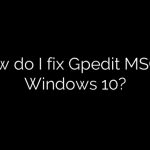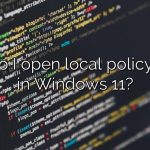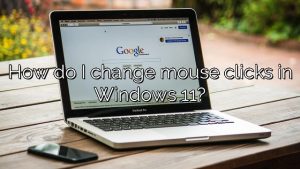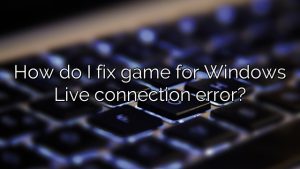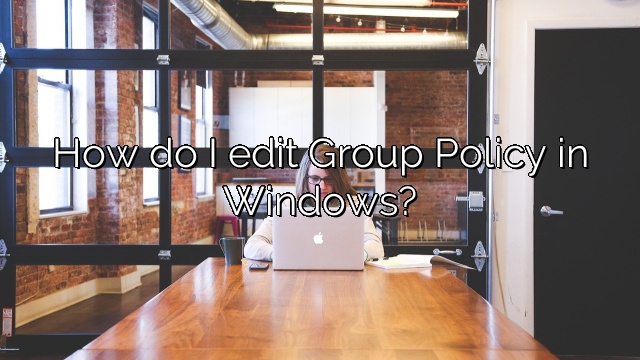
How do I edit Group Policy in Windows?
Click the Start button and type Gpedit. msc, and you should see the tool appear in the result click on it (or use the Run command with Win + R, followed by Gpedit. msc), and you will be able to access the Group Policy Editor.
Does Windows 11 home have Group Policy Editor?
Windows 11 has a new feature called the Group Policy Editor (Gpedit.msc) that is used to view, configure, and modify Group Policy configurations. It is used to allow administrators to apply system-wide policy buttons that simultaneously affect all users in a large network.
How do I edit Group Policy in Windows?
Step 1: Log in to the domain as a controller administrator.
Step related to – Run the political institution management tool. 3
Step. Navigate to the desired organizational unit.
Step 4 – Edit Group Policy.
How to open Local Group Policy Editor in Windows 11?
Open the Windows 11 Local Group Policy Editor from the Control Panel. Open Control Panel for Windows 11; To do this, press Win + R and enter a control that brings up the Run dialog box.
Click “Find a career” in the upper right corner of the window.
Start typing a group. In the search results, you will find the Edit Group Policy option.
How to access Group Policy Management editor?
Windows 10, 8, 8.1 users can use Command Prompt to access the Local Policy Group Editor: press Windows logo key + X key combination.
Select “Command Prompt (Admin)” from the “Quick Boost” menu.
Enter gpedit. And msc press enter.
How to enable Group Policy?
On the Group Policy Management computer, open the Group Policy Management Console, right-click the Group Policy Object (GPO) that you want to organize, and then select Edit.
Using the Group Policy Management Editor, navigate to Computer Configuration.
Click Administrative Templates.
Expand the tree to Components > Microsoft Defender Antivirus Window.
more toys
How to manually force update Group Policy settings in Windows?
In the GPMC console tree, locate the domain in which you want to configure computers to enable Group Policy Remote Update.
Right click on the selected domain and click “Create a GPO for this domain” and link the item here…
In the New GPO dialog box, enter a name for the new GPO in the Name field.
More articles
What is group policy and Group Policy Object?
A Group Policy Object (GPO) is a type of online collection of policy settings. The other GPO has a unique name, such as a GUID. The Group Policy settings are, of course, contained in the GPO. A GPO can represent policy settings in a specific file system and in Active Directory.
Can local group policy override domain group policy?
Local policies require policy domain overrides. It could be several types of Group Policy Preferences that changed the settings, as this watermark will also remain until the GPP is removed. You may want to check the registry. I would definitely move it to OU, it’s perfectly clean and about to start.
What is the difference between a group policy and a group policy preference?
The policy is removed when the GPO goes out of scope, i.e. when the user and computer are no longer affected, and the GPO is also no longer affected. However, the setting is still configured for the target user or other computer, even if the GPO is out of scope.
What was Group Policy before Group Policy Preferences?
Prior to Grouping Policies (GPP) settings, everything was blocked in a policy group. When GPPs were first released, many administrators requested an administrative template (also known as a policy setting). Many consumer preference actions were changed to “Replace” and “Remove this item if no longer applicable” was treated as a set of options.
What is the difference between a local group policy and a domain group policy?
5 answers. Local coverage extends to the local computer. Group Policy is applied to all domain computers on the network based on the settings, security policies, filters, etc. available in the scope applied locally on the computer, such as when you are signed in to a workgroup.
What is the difference between a Group Policy and a Group Policy preference?
The policy is removed when the GPO expires, that is, when the user or computer system no longer targets the underlying GPO. However, the preference remains in effect for the target user or actual computer when the GPO goes out of scope. … If the protection is removed later, the most important client registry settings will be restored.

Charles Howell is a freelance writer and editor. He has been writing about consumer electronics, how-to guides, and the latest news in the tech world for over 10 years. His work has been featured on a variety of websites, including techcrunch.com, where he is a contributor. When he’s not writing or spending time with his family, he enjoys playing tennis and exploring new restaurants in the area.


